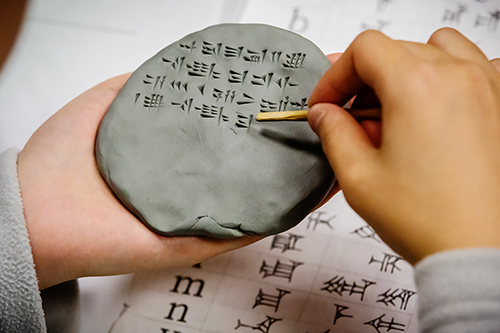

Daniel Stelzer used a stylus to carefully form symbols in a piece of clay. The University of Illinois student was practicing writing the symbols in a class on Hittite, an ancient language that uses cuneiform, one of the oldest human writing systems.
The U of I offered the class in Hittite for the first time this fall.
“I’m doing it partly because it’s so impractical. I think there should still be space at the university for studying things that are impractical, simply because they are interesting and open up a new world to your students,” said Ryan Shosted, a linguistics professor who is teaching the class.
Hittite is an extinct language – no one speaks it. It was used in the Bronze Age by people living in what is now Turkey. Hittite is an Indo-European language, from the same family as Russian, English, Irish and Hindi. The students in Shosted’s class study ancient texts and learn basic vocabulary and language structure, how to read and write Hittite in cuneiform as well as in the Roman alphabet, and about Hittite culture. They’ve translated texts about a priest floating a model boat down a river in order to cast away evil and about the ritual sacrifice of a sheep.
For Stelzer – who is majoring in linguistics and computer science – learning the language is like solving a puzzle.

“Linguistics is all about studying the mental structures of languages, the rules that native speakers know subconsciously, and with a language like Hittite, those structures are entirely gone. It’s like a puzzle, trying to piece together what we can figure out from the scraps and fragments that survived,” Stelzer said.
It is a way for students to apply their linguistic knowledge to a difficult problem, Shosted said, and it helps them to better understand how a family of languages developed and evolved.
The class is a mix of 21st-century and Bronze Age technology. Many of the assignments are delivered online, but in class, the students work together on translation and grammatical exercises and they practice how to press cuneiform symbols into clay. They do some assignments in clay, take photos of them and upload them to an open-source learning platform.
“A hallmark feature of the class is giving students the opportunity to write in clay and have the Bronze Age experience to write how the Hittite scribes wrote,” Shosted said. “I think of it as half art class. I want them to make beautiful tablets, and I want it to look right.”
Cuneiform – which is used for the Hittite language, as well as Sumerian, Akkadian and others – consists of wedge-shaped marks positioned vertically, horizontally or diagonally, as well as a hook-shaped mark that does not have a tail as the others do. Various marks positioned together form the characters of the language.

“The page is full of triangles of various shapes,” said Genevieve Scheele, a graduate student in classics who is taking the Hittite course. “It’s not my favorite writing system. It’s difficult to make and to read, because there are so many characters that look alike.”
Learning cuneiform drew her to the class, though. Once she learns it with Hittite, she’ll add the Sumerian and Akkadian languages.
“I’m a dead languages nerd,” Scheele said. “I’m particularly interested in historical linguistics. I came to classics from religion, doing biblical studies, so Hittite is pertinent to Indo-European languages and other studies with ancient near-Eastern cultures.
“It’s not the first ancient language course I’ve taken, but it’s the first I’ve taken that deals with reading tablets,” she said. “Right from the first two weeks of the semester to be reading tablets and autographs and learning how to interact with the language in that way has been a fun and novel experience and sparked more of my interest in the field.”
Scheele is interested in linguistic epistemology – the relationship between language and how we think, or why language is the way it is. She’s taken courses in Japanese and Hebrew, but she finds Hittite particularly formidable.
“It’s an interesting challenge for me, learning a new writing system,” Scheele said. “With Japanese, even though there are thousands of characters, there’s a system to it that makes sense. With Hebrew, there’s a system that makes sense. So far with cuneiform, there’s no system that makes sense. It challenges me because it doesn’t fit the models I know.”
Stelzer said there is a natural connection between linguistics and computer science, but particularly so with a language such as Hittite. Both have the aspect of a puzzle, in analyzing the data available and piecing together the hidden rules behind a system. He’s interested in finding ways for computers to better understand and use languages.
When Stelzer wanted to make a meme with some text in cuneiform, he found only one font with Hittite symbols that was very difficult to use. To avoid accessibility issues for students who might not be able to see the font on their computers, Shosted had been doing the tedious work of making assignments by positioning vector graphics of each symbol individually. Stelzer wrote a computer program to automatically convert a line of alphabetic text into a single image filled with the equivalent cuneiform symbols.
But he also enjoys working with the clay to write in the same way Hittites did during the Bronze Age.
“It’s a wonderful break from what I spend the rest of my week doing,” Stelzer said.


